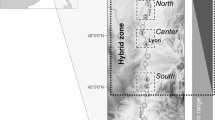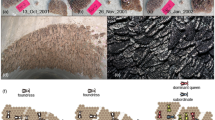Abstract
SOCIAL insects are characterized by indirect reproduction, in which most individuals achieve genetic success by helping to rear the offspring of colony mates. The evolution of such systems is expected to be sensitive to the genetic relatedness of colony mates. In general, reproductive altruism evolves most easily when relatedness is high, although it could be maintained under regimes of low relatedness after morphologically distinct castes have evolved1,2. Most social insects belong to the order Hymenoptera, and are therefore haplodiploid (males haploid, females diploid); this genetic system may favour the evolution of altruism because it makes rearing a full sister (r = ¾) genetically more valuable than rearing one's own offspring (r = ½) (refs 1–3). Here we report new estimates of relatedness from 14 species of polistine wasps lacking morphological castes. Female colony mates are often not full sisters and therefore seldom realize the full advantage made possible by haplodiploidy. But relatedness is always fairly high, in striking contrast to the situation in some species with morphological castes.
This is a preview of subscription content, access via your institution
Access options
Subscribe to this journal
Receive 51 print issues and online access
$199.00 per year
only $3.90 per issue
Buy this article
- Purchase on Springer Link
- Instant access to full article PDF
Prices may be subject to local taxes which are calculated during checkout
Similar content being viewed by others
References
Hamilton, W. D. J. theor. Biol. 7, 1–52 (1964).
Hamilton, W. D. A. Rev. Ecol. Syste. 3, 193–232 (1972).
Trivers, R. L. & Hare, H. Science 191, 249–263 (1976).
Craig, R. & Crazier, R. H. Evolution 33, 335–341 (1979).
Pamilo, P. & Varvio-Aho, S.-L. Behav. Ecol. Sociobiol. 6, 91–98 (1979).
Pamilo, P. & Crozier, R. H. Theor. Popul. Biol. 21, 171–193 (1982).
Pamilo, P. Genetics 107, 307–320 (1984).
Queller, D. C. & Goodnight, K. F. Evolution 43, 258–275 (1989).
Crozier, R. H., Smith, B. H. & Crozier, Y. C. Evolution 41, 902–910 (1987).
Kukuk, P. F. in Genetics of Social Evolution (eds Breed, M. D. & Page, R. E.) 183–202 (Westview, Boulder, 1989).
Schwarz, M. P. Behav. Ecol. Sociobiol. 21, 387–392 (1987).
Ross, K. G. & Matthews, R. W. Amer. Nat. (in the press).
Pardi, L. Boll. 1st. Entom. Univ. Bologna 15, 25–84 (1942).
West-Eberhard, M. J. Misc. Publ. Mus. Zool. Univ. Mich. 140, 1–101 (1969).
Litte, M. Behav. Ecol. Sociobiol. 2, 229–246 (1977).
Strassmann, J. E. Z. Tierpsychol. 69, 141–148 (1985).
Metcalf, R. A. & Whitt, G. S. Behav. Ecol. Sociobiol. 2, 339–351 (1977).
Lester, L. J. & Selander, R. K. Amer. Nat. 117, 147–176 (1981).
Queller, D. C., Strassmann, J. E. & Hughes, C. R. Science 242, 1155–1157 (1988).
Strassmann, J. E. Science 204, 207–209 (1979).
Frumhoff, P. C. & Schneider, S. Anim. Behav. 35, 255–262 (1986).
Page, R. E., Robinson, G. E. & Fondrk, M. K. Nature 338, 576–579 (1989).
Gamboa, G. J., Reeve, H. K. & Pfennig, D. W. A. Rev. Entomol. 31, 431–454 (1986).
Metcalf, R. A. & Whitt, G. S. Behav. Ecol. Sociobiol. 2, 353–360 (1977).
Noonan, K. M. in Natural Selection and Social Behavior (eds Alexander, R. D. & Tinkle, D. W.) 18–44 (Chiron, New York, 1981).
Strassmann, J. E., Queller, D. C. & Hughes, C. R. Ecology 69, 1497–1505 (1988).
Queller, D. C. Proc. natn. Acad. Sci. U.S.A. 86, 3224–3226 (1989).
Ross, K. G. Nature 323, 398–400 (1986).
Pamilo, P. Heredity 48, 95–106 (1982).
Pearson, B. Behav. Ecol. Sociobiol. 12, 1–4 (1983).
Ross, K. G. & Fletcher, D. J. C. Behav. Ecol. Sociobiol. 17, 349–356 (1985).
Author information
Authors and Affiliations
Rights and permissions
About this article
Cite this article
Strassmann, J., Hughes, C., Queller, D. et al. Genetic relatedness in primitively eusocial wasps. Nature 342, 268–270 (1989). https://doi.org/10.1038/342268a0
Received:
Accepted:
Issue Date:
DOI: https://doi.org/10.1038/342268a0
This article is cited by
-
Genetic relatedness does not predict the queen’s successors in the primitively eusocial wasp, Ropalidia marginata
Journal of Genetics (2018)
-
Colony structure and reproductive sharing among queens in a tropical paper wasp, Polistes olivaceus
Insectes Sociaux (2012)
-
Incipient morphological castes in Polistes gallicus (Vespidae, Hymenoptera)
Zoomorphology (2011)
-
Pattern of settlement and natural chimerism in the colonial urochordate Botryllus schlosseri
Genetica (2007)
-
Unrelated helpers in a social insect
Nature (2000)
Comments
By submitting a comment you agree to abide by our Terms and Community Guidelines. If you find something abusive or that does not comply with our terms or guidelines please flag it as inappropriate.



